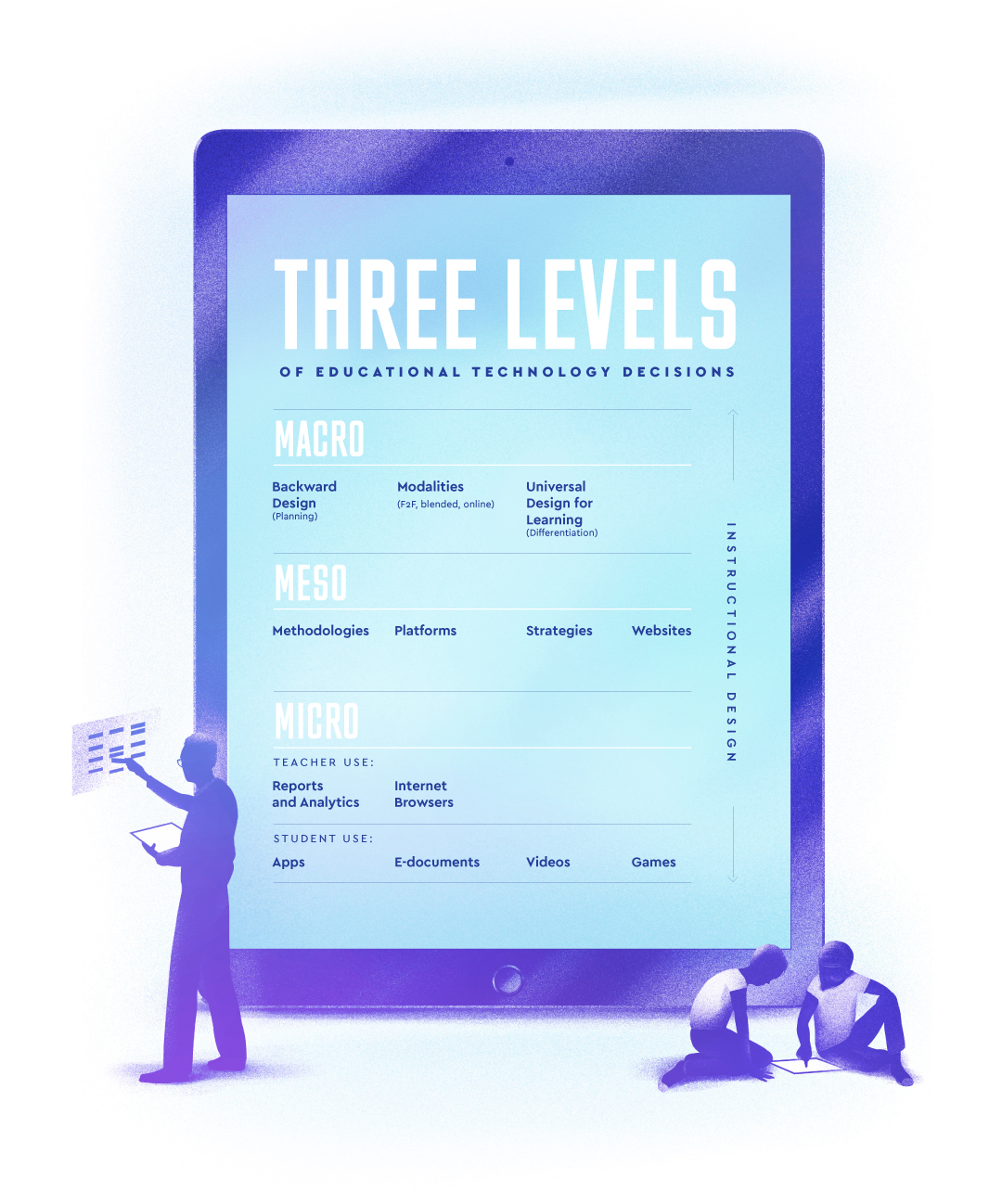
Technology
Leveraging emerging Technology
for effective teaching and learning
February 10, 2021
Emerging technologies have huge potential to improve teaching and learning, and to create networked communities of learners around the world.
©DANIEL STOLLE
By Cynthia Borja, Mishel Tirira, Tracey Tokuhama-Espinosa
10/02/ 2021
·
- Share
New technologies are full of promise. They are constantly evolving and adapting to an ever-changing world and to users’ needs. Technological tools can be found for nearly every aspect of life. Chances are that if you can imagine a practical need in your life, a tool exists to facilitate it, including in education. A simple search on a phone results in thousands of options that a teacher can use to facilitate classroom learning. Rather than being at a loss for resources, educators, students, and teachers are challenged by choice.
To better understand the variety of educational tools available to teachers, it is helpful to divide them into different levels. At a macro level, technologies related to instructional design elements, such as those that promote classroom differentiation (e.g., Universal Design for Learning), and planning tools, such as Backward Design, help teachers choose the most appropriate resources. At the meso level, learning management systems (LMS) such as Canvas, Moodle, Edmodo, ALEKS, Google Classroom and Blackboard allow online courses to be built, and collections of such courses are already available on open learning platforms such as Udemy. The meso level also includes websites that collate activities, lesson plans and other resources for teachers (e.g., Funbrain, Hippocampus, HowDesignU, and Instatation). Finally, at the micro level, are video games, apps, software, and other tools for learning, which are mostly used directly by learners and are not necessarily under a teacher’s guidance, though they generally complement school objectives in specific subject areas such as languages or mathematics.
One of the most attractive features of emerging technologies is that they fill a void related to quality. Through emerging technologies, however, students can download free apps onto devices they already have, such as cell phones, and teachers can access a level of expertise that might not otherwise have been available in their own institutions due to limited funds. For example, schools that require but cannot afford to employ expert English teachers might access video tutorials on YouTube; Zearn can be used to aid maths curriculum planning; field trips can be incorporated into teaching using Discovery Education MindsetWorks; and even the development of positive growth mindsets can be supported through the Growth Mindsets App. All of these are available free of charge and open to anyone with access to the internet. Unfortunately, while 7 out of 10 students from member countries of the Organisation for Economic Co-operation and Development (OECD) use computers at school (OECD, 2015), many schools, especially those in poorer countries, do not have these resources.
In education, emerging technologies include both tools and practices (Veletsianos, 2010). Hence, emerging technologies and practices include software, concepts, pedagogies, methodologies, innovations, and advancements in education. Emerging technologies include all the elements that a teacher might need in their “toolbox” to help achieve learning outcomes, which can be classified in three categories: macro, meso, and micro (Tokuhama-Espinosa, Borja, and Tirira, 2018).
Emerging technologies and practices for improved learning outcomes
Emerging technologies and practices support teaching processes and learning outcomes. They facilitate inclusion (e.g., ModMath) by using multi-modal representations of concepts and help make education accessible to all through free access and/or ease of use by different age groups (e.g., Rewordify and Padlet). They construct a more globalized world, bringing together instructors and learners from different countries (e.g., Conversations Unbound). They improve learning outcomes by personalizing content (e.g., LearnSmart and Engrade) and tailor learning processes to each student’s needs (e.g., Khan Academy and The Number Race). They lead to strategically planned activities that respond to learning outcomes and objectives (e.g., Backward Design) and maximize classroom time for deeper and more significant learning (e.g., flipped classrooms). Many teachers have learned to use these tools to complement their regular teaching material, activities, and practices.

The new functionalities integrated into online courses to facilitate student interaction increase social exchange, the authentic use of language and skill sets, and can be more motivating than common classroom experiences.
The evolving online education model and platforms
Emerging technologies and practices broaden opportunities to interconnect people from around the world. Online and distance enrolments have grown steadily for over a decade (Seaman, Allen, and Seaman, 2018); in 2017, online enrolments grew by 3 per cent and have risen steadily ever since (Magda and Aslanian, 2018). The online learning model used to be a system in which students interacted in an independent way with course materials in a virtual classroom, and in an asynchronous manner with their peers, rarely, if ever, making direct contact with other learners or engaging in true dialogue or debate. Today, the online learning modality promotes the development of close-knit learning communities that bring together learners from around the world.
As a result of evolving technologies and practices, and teachers’ imaginations, online learning has been favourably reinvented, in both asynchronous and synchronous learning experiences. Massive Open Online Courses (MOOCs) are online asynchronous courses, usually created by universities, that are accessible to individuals around the world for free or for a very modest cost. In the last two decades, the world has seen an exponential rise in the number of MOOCs—in 2018, more than 900 universities had offered one or more MOOCs and over 101 million students had benefited from these types of courses (Shah, 2018). Some of the better-known MOOC platforms are Coursera, founded at Stanford, and EdX, developed at MIT and Harvard. While MOOCs have increased and democratized access to online courses, most maintain the asynchronous and impersonal elements for which online education has been criticized. This is slowly changing thanks to emerging technologies. Synchronous online course models are on the rise.
Synchronous courses meet regularly and often use teleconferencing technology to facilitate face-to-face online exchanges through tools such as Adobe Connect, Skype, Webex, or Zoom (Ghazal, Samsudin, and Aldowah, 2015; Pearl and Vasquez III, 2016; Liu, Stapleton, and Stephen, 2017; Scanga, Deen, Smith, and Wright, 2018). We know that our brains detect facial expressions and tones of voices immediately and unconsciously, and that these elements affect student motivation and learning (Tokuhama-Espinosa, 2019). Interacting with students in ways that include these elements are key to student learning. In this sense, emerging technologies add “true” visual, voice and face-to-face exchanges to online learning.
LMS platforms now also incorporate different types of activities, such as social discussion boards, interactive multiple-user games, chat options, and polls, which contain text, images, and videos that attract learners to more interesting learning adventures. Through these elements, students interact more with classmates and use a far greater number of modalities to reinforce learning than in normal classrooms. As active learning and student engagement are key to learning (Freeman, Eddy, McDonough, Smith, Okoroafor, Jordt, and Wenderoth, 2014; Finn and Zimmer, 2012), emerging technologies have evolved to socially and emotionally engage students more than was possible just a decade ago. The new functionalities integrated into online courses to facilitate student interaction increase social exchange, authentic use of language and skill sets, and can be more motivating than common classroom experiences.
Engagement in learning is key to educational outcomes, online or otherwise. Whereas just a few years ago, online education was criticized for being impersonal, (Finn and Zimmer, 2012; de Freitas, Morgan, and Gibson, 2015), today’s emerging technologies have proven to be the opposite. Student participation, application of learned knowledge and social exchanges can all be enhanced with the right choice of technology (Heller, 2018; Tokuhama-Espinosa, 2018). Teachers can use tools such as Flipgrid to transform student discussions into video-based exchanges, enhancing the dynamics of student debate (Stoszkowski, 2018). Thus, students perceive a more genuine interaction with their peers (Jones-Roberts, 2018) and interact more with one another. Teachers can also use tools that incorporate voice (e.g., Adobe Acrobat Reader and Kaizena) and video (e.g., Jing) to provide feedback to students in more efficient and personalized ways (Keane, McCrea, and Russell, 2018; Flood, Hayden, Bourke, Gallagher, and Maher, 2017).
One of the appeals of online learning is that the learner and instructor are not confined by the physical elements that limit face-to-face learning. In online modalities of learning, a person in Italy interacts with another learner in Kenya, with the guidance of their instructor who is in Brazil, without leaving their jobs, homes and families, and with less economic burden than traditional institutional structures. Educational systems designed for K-12, university, as well as for training purposes, are growing at an exponential rate, and in more diverse settings with global classrooms and exchanges of ideas and perspectives (Magda and Aslanian, 2018). These kinds of exchanges between people of different backgrounds has the additional benefit of reducing racial bias, contributing to a more tolerant and accepting world (Tokuhama-Espinosa, 2017).

One of the appeals of online learning is that the learner and instructor are not confined by the physical elements that limit face-to-face learning. In online modalities of learning, a person in Italy interacts with another learner in Kenya, with the guidance of their instructor who is in Brazil, without leaving their jobs, homes and families, and with less economic burden than traditional institutional structures.
Informing teaching and learning with big data
Another major area that lends itself to better educational choice is the way big data can be leveraged, especially in areas that were previously difficult to measure. To make data collection and analysis simpler, many of the meso-level educational tools are now being used to gather this data. This information is then analysed to understand student behavior, learning processes and the effects of teacher and institutional practices on student learning (Dawson, McWilliam, and Tan, 2008). LMS platforms, for example, gather massive amounts of data regarding student behaviour within the platform. They record the number of clicks a student makes, how long they stay on one particular page, what material they engage with the most, which quiz questions they spend most time on, or how many times they change their mind regarding an answer. Some video conference tools (e.g., Zoom) record whether a student is paying attention to a class, or if the student is exploring other programs while in class.
Tools that are integrated in education systems keep a record and give teachers real and immediate data about student progress, behaviour and learning. With this information, teachers can visualize the effect of their methods on the learning processes and confirm that a planned learning objective is achieved. Data gives teachers and education institutions the power to evaluate and adapt their practice in real time and with the support of evidence.
Making personalized learning a reality
Personalization of education and learning processes used to require numerous hours creating individual education plans, activities, tasks and homework to adapt class content to a student’s needs. Although mostly manageable with small groups, this has proven to be a challenge and concern for teachers with larger groups of students (Shah, Das, Desai, and Tiwari, 2016; Roberts and Simpson, 2016).
Emerging technologies provide teachers with tools that personalize, differentiate and adapt the learning process to each individual in more efficient and effective ways. Emerging technologies give students tools that allow them to reinforce learning beyond their contact time with teachers. These technological tools can reinforce particular concepts or abilities in the student’s own time, adapting learning to the student’s needs, without over-taxing the teacher. It also allows the teacher to focus on working with learners who might have special needs that cannot be supported with existing technologies. Memrise, for example, is a digital language flashcard platform that facilitates independent language learning and practice, which can help students reinforce basic vocabulary in an entertaining way (Scholz, 2018; Walker, 2015). Other tools teach students how better to synthesize ideas. For example, SMMRY reinforces summary writing abilities and does so at a student’s own pace. Other resources provide personalized tutorials for students, taking the burden of extra classes off teachers and putting it onto the internet. For example, Khan Academy and SchoolTube websites provide students with videos to review course concepts as many times as they need to understand the material. Whereas some students in the class may need just a few repetitions of a concept to be able to advance, others who have less prior experience with the core concepts may need to review prerequisite concepts multiple times before advancing. Teachers can assign this rehearsal to the student’s own time, rather than using class time or additional after-hours tutoring.
Course materials have also changed drastically with the advent of emerging technologies, moving away from the traditional “single textbook system”. We now know that the brain learns best when learning is differentiated and scaffolded on prior experiences, which are unique to the individual, meaning that the same text for all is not the best way to learn (Bada and Olusegun, 2015; Schöllhorn, Hegen, and Davids, 2012). Emerging technologies have created an unprecedented opportunity to differentiate course materials for each student. Since students have constant access to diverse material on the same topic, teachers can leverage this information availability to tailor the information each student receives. Teachers can use the online encyclopedia Wikipedia, for example, to provide students with information that is written in simple layman’s language, or Google Scholar, an academic search engine, for empirical, scholarly information. Free and open-access technologies permit teachers to adapt the materials used to their students’ different levels of prior knowledge about the topic, allowing learners to fill in any gaps in prerequisite knowledge and be prepared to work at the same pace within the classroom structure. This allows remediation to occur outside the class so that classwork itself can be advanced as a group.
When students use these emerging technologies on their own, their learning becomes differentiated from the needs and preferences of other learners. This changes the teacher’s job from being the person who has to execute the intervention, to being a designer who has to identify which tool best responds to the needs of each learner. In this way, learning becomes differentiated without overloading the teacher and without compromising learning outcomes. Additionally, by implementing choice and autonomy in the differentiation process, student motivation and student engagement are increased (Christenson, Reschly, and Wylie, 2012).
One of the most challenging elements of differentiation in education has been adapting course material or classes to the needs of students with specific difficulties or disabilities (learning or otherwise). In the past, entire teams of people would spend many hours working on adapting course material to different modalities and formats. Schools would hire “note-takers” to allow students who experienced difficulties in writing (such as those with dyslexia) to have summary class materials; children with auditory processing difficulties would require interpreters to access in-class information or be given different timeframes to complete assignments; those with attention problems had to be separated from their peers in order to concentrate; and blind students were often sent to special schools.
Emerging technologies have made great leaps to facilitate the fuller integration of students with special needs into regular classrooms. Students now have access to information presented in class, in real time, in the format they require. Those who have difficulties with note-taking or auditory or speech difficulties now use apps such as Ghost Reader, which translates speech into text. Video conferencing tools, such as Zoom, incorporate closed caption functions providing written transcripts of oral exchanges. Pages such as WeCapable translate text into American Sign Language (spelling out words with hand gestures) or convert verbal messages into gestured sign language, and vice versa (e.g., KinTrans).

Emerging technologies have made great leaps to facilitate the fuller integration of students with special needs into regular classrooms.
Supporting engagement and deep and authentic learning
A final example of the power of emerging technologies comes from the promise of artificial intelligence, virtual reality and augmented reality. Teachers have always been challenged to find ways to support engagement and involve their students in activities that lead to deep and authentic learning. Emerging technologies make active learning processes simpler to implement in direct instruction and out-of-class activities. For instance, mobile labs such as Labster (Bonde, Makransky, Wandall, Larsen, Morsing, Jarmer, and Sommer, 2014) and Lab4U provide students with a virtual experience of performing experiments in a “million-dollar laboratory”, which would have been unheard of for students in less developed countries before. This virtual experience significantly heightens authentic learning processes as well as student engagement and participation in interactive lessons (Smith and Coleman, 2017). Virtual reality experiences permit students in Canada to walk the Inca trail in Peru, or those in land-locked Bolivia to go on a deep-sea ocean excavation. Augmented reality technologies involve students in more active and realistic learning. Examples include apps that make books come to life, such as Books with Magic and Books with Augmented Reality, which further enhance the entertainment value of story reading, and also provide enhanced perspective-taking by altering the viewpoint of the characters. Lifeliqe is another example, which uses 3D and augmented reality models of common core science curricula elements to create experiences with elements normally too microscopic or macroscopic to understand. Wearable technologies, such as virtual reality glasses, create realistic experiences for students (e.g., Google Expeditions, Learn Around the World, Oculus Rift, and Unimersiv; see Brown and Green, 2016).

The learning sciences as a framework for technology use
Technology is complemented by the learning sciences. The selection of an emerging technology in a class by a teacher, or in a school by an administrator, should be guided by a clear objective, and the selection of objectives must be guided by an understanding of human learning. Choosing the right technology depends on the teacher’s ability to identify clear objectives and schools identifying specific educational outcomes. The objectives and outcomes, in turn, rest squarely on the educators’ knowledge about the brain and how humans learn.
For example, if a teacher has a clearly identified goal of social-emotional learning, Pear Deck, which leverages attention and memory processes in the brain based on emotional regulation, is a great choice, even if it is not the best tool to reinforce language skills or to teach maths. The choice of a tool should not be based on its entertainment value or popularity with students but rather on the role it will play in helping teachers reach a specific educational goal. If a teacher wants students to improve vocabulary using rote memory skills, for example, then Memrise is a good option, whereas if they want to improve pronunciation of that vocabulary, then Duolingo is a better choice. If a teacher is clear that one of their primary objectives is to improve community-building and enhance the role of families in student learning, then Bloomz is a good option. This means that emerging technologies force teachers to more precisely select teaching tools that hone in on specific educational competencies. Matching clear objectives with knowledge of the learning brain permits teachers to broaden their toolkit of options.
The learning sciences also encourage the differentiation of resources. Given the free and open nature of many learning platforms, free Apps, texts, videos, and podcasts can be gathered and offered to students at distinct entry points of learning. This increases the likelihood that student needs will be addressed on an individual level. Artificial intelligence is combined with many emerging technologies to share more individual learning experiences. In many programs that rehearse specific skills within the domains of language and math, for example, the programs are armed with algorithms that adjust to the learner’s needs so that they remain motivated to practise the skills enough times to master them. Artificial intelligence is also being used to design technologies that serve as “virtual tutors” and that correct and guide learners in simple grammar or vocabulary use, for example, thus freeing up time for teachers, allowing them the opportunity to offer more constructive and creative feedback about their students’ learning.

As with all educational resources throughout history, these technologies are just tools, not solutions in and of themselves. In turn, tools are only as good as the person who uses them.
The promise of emerging technologies depends on teacher training
Emerging technologies are powerful teaching tools in the classroom, but only if the teacher selects the right tools based on clear objectives. As with all educational resources throughout history, these technologies are just tools, not solutions in and of themselves. In turn, tools are only as good as the person who uses them. While national or institutional policies can be conducive to the use of digital resources in the classroom, taking advantage of emergent technologies depends on the use that teachers give to them and this requires additional training. An OECD report (2017) identified knowledge of technology and how to integrate it into the classroom as one of the biggest challenges that governments face. More than merely knowing that a tool exists, teachers must be trained in how to select the best tools for the learning objectives at hand. The key to unlocking these resources lies in the quality of teacher education. As noted in another OECD report, “technology can amplify great teaching, but great technology cannot replace poor teaching” (OECD, 2015). Teacher education must be modernized and teachers’ potential maximized by incorporating the new information from technology and neuroscience into their teaching.
Without quality teachers there is no such thing as quality education. Investment in teacher training should take precedence over investment in new digital technology; the tools do not work by themselves. Teachers without basic training see technology as a barrier rather than a tool to be utilized to maximize student potential. With the right tools and the right training, however, emergent technologies offer an unprecedented opportunity to increase access to and quality of education.

